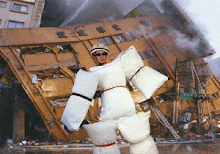Another holiday is just around the corner.
vv
The Chinese New Year starts next week for the year of the rat.
vv
Here's a photo of a Cai Guo-qiang firework to help celebrate.
Everything is dangerous, and in one minute our lives could be transformed immeasurably regardless of our economic or educational status, ethnicity or gender. Disasters define our humanity; as French author Marcel Proust wrote: “Disaster puts one in touch with oneself: suffering fuels creativity.” However, in a morbid way, disasters do unify us as a people, and unfortunately, tend to be more unifying than art.
Another holiday is just around the corner.
vv
The Chinese New Year starts next week for the year of the rat.
vv
Here's a photo of a Cai Guo-qiang firework to help celebrate.
Posted by
Susan
at
10:47 PM
0
comments
![]()
Posted by
Susan
at
1:47 AM
0
comments
![]()
Posted by
Susan
at
1:45 PM
0
comments
![]()
Posted by
Susan
at
12:55 AM
0
comments
![]()
I went down to the river,
I set down on the bank.
I tried to think but couldn't,
So I jumped in and sank.
vv
I came up once and hollered!
I came up twice and cried!
If that water hadn't a-been so cold
I might've sunk and died.
vv
But it was Cold in that water! It was cold!
vv
I took the elevator
Sixteen floors above the ground.
I thought about my baby
And thought I would jump down.
vv
I stood there and I hollered!
I stood there and I cried!
If it hadn't a-been so high
I might've jumped and died.
vv
But it was High up there! It was high!
vv
So since I'm still here livin',
I guess I will live on.
I could've died for love--
But for livin' I was born
vv
Though you may hear me holler,
And you may see me cry--
I'll be dogged, sweet baby,
If you gonna see me die.
vv
Life is fine! Fine as wine! Life is fine!
Posted by
Susan
at
10:20 PM
0
comments
![]()
Posted by
Susan
at
10:39 PM
0
comments
![]()
Posted by
Susan
at
10:34 PM
0
comments
![]()
Posted by
Susan
at
12:50 AM
1 comments
![]()

Good, now I have the perfect opportunity to write about one of my favorite artists, Roman Signer.
vv
He's currently having an exhibition at The Fruitmarket Gallery in Edinburgh, Scotland.
vv
The photo comes from www.eflux.com, also a fave of mine (the website that is.) Titled Office Chair, this film shows the artist spinning around in the chair solely by the force of the fireworks that he's holding.
vv
Often humorous at first glance, his work pushes the boundaries of the expectations of art and the functions of cotidian objects while scientically and aesthetically exploring the laws of physics, and ultimately the role that our body plays in the much larger scheme of the universe.
Posted by
Susan
at
12:44 AM
0
comments
![]()
Posted by
Susan
at
2:38 AM
0
comments
![]()
Posted by
Susan
at
2:06 AM
0
comments
![]()
Pre-2007 photo of Hermann Nitsch performance courtesy of http://www.slought.org/img/archive1/1264+press1.jpg
vv
vv
1. International biennials are still going strong. And why not? It makes strong business sense as it is good for civic enterprises and local tourism. It also presents a muy simpatico face to the world, in the case of countries whose politics are a bit messy.
vv
2. The art market dominates the media. Most western journalism covers the auctions and the high rollers. Have you read a mainstream piece that purely discusses the work of art and its philosophical ideas and metaphors the artist wishes to convey to the public? I highly doubt it. Editors and readers prefer sensationalism over profound thought. This is one reason why I read the sports pages rather than the arts, as the sports pages seem to comment on society at large (making me ponder about the world I live in) while, in general, arts writing tends to have its head stuck up its arse.
vv
3. Chinese art from China is still hot in the US and Europe. But has the western world really gained a deeper understanding about Chinese culture or is this just a form of post-colonial acquisition on one side and frenzied selling out on the other?
vv
4. Political messages in art were the exception rather than the norm. Collectively we all know that war, poverty, genocide are terrible things and maybe we’re inure to hearing/ seeing/ receiving such messages in art. Perhaps politics in art aren’t so sexy, unless Angelina Jolie is involved, and maybe which is why we don’t see such outrage in the art world like there was in the ‘60s. In 2007, there were some feminist retrospectives in the US. I didn’t see them, but wasn’t it saying feminism is safely tucked away in the past and we can look at it historically as it is no longer a menace?
vv
5. Performance art is stronger than ever. It taps into the audience’s memory of parties and festive occasions. It hints that something significant may happen so that you want to be there in person to witness it. Celebrities may also attend it, but it is art at the same time, so it is a bit cerebral, and enlightening too, isn’t it? Have you noticed that some of the big art moments for 2007 were getting infected with the dust of celebrity-ism?
Posted by
Susan
at
1:00 AM
0
comments
![]()
Posted by
Susan
at
5:12 PM
0
comments
![]()
